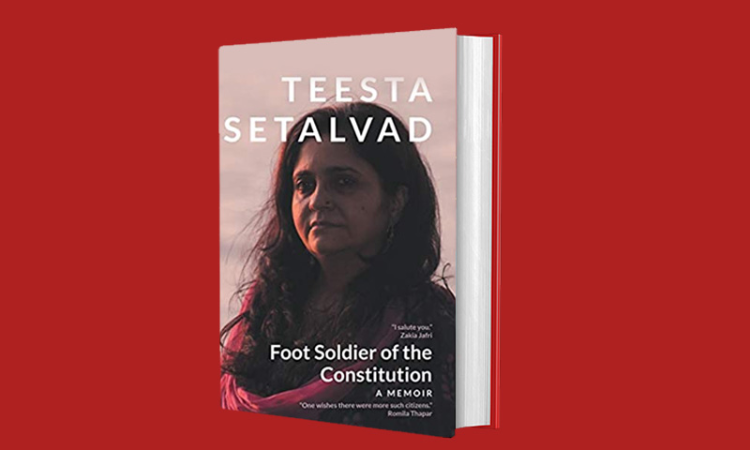- Home
- /
- Book Reviews
- /
- Book Review – Foot Soldier Of The...
Book Review – Foot Soldier Of The Constitution: A Memoir
Shrikrishna S. Kachave
28 May 2020 4:36 AM GMT
"Foot Soldier of the Constitution: A memoir" is a non-fiction authored by Teesta Setalvad, a journalist and an activist who currently manages Sabrang India (formerly 'Communalism Combat') and Citizens for Justice and Peace (CJP). The author is known to be one of those rare people, probably feared by the politician featured as the most influential and powerful by Time (2017) and Forbes...
"Foot Soldier of the Constitution: A memoir" is a non-fiction authored by Teesta Setalvad, a journalist and an activist who currently manages Sabrang India (formerly 'Communalism Combat') and Citizens for Justice and Peace (CJP). The author is known to be one of those rare people, probably feared by the politician featured as the most influential and powerful by Time (2017) and Forbes (2018) respectively. The reason for such would be better known subsequently reading this book.
The book begins with (Chapter I – Opening) emphasizing the life of author during her stint as a journalist with 'The Daily' in 1983. The author further shares her experience as a reporter covering the 1984 riots that occurred in Bombay. It also provides an overview to the history of riots instigated by the right wing organizations of the country since 1980s.
The author in this chapter significantly introduces the Godhra incident of 27 February 2002 which was later transpired into a pogrom across Gujarat and in nation widespread. The author has greatly contributed with the minutiae of this entire Godhra incident which later resulted into a genocide to be known as the 2002 Gujarat riots.
"Chapter II – Roots" lays a vivid account of the author's childhood dwelt in Bombay. It also narrates the historic role of Sir Chimanlal Setalvad (member of Hunter Commission and great-grandfather of author) cross-examining General Reginald Dyer for the Jallianwala Bagh massacre happened in 1919. The author has also elucidated her simple and disciplined upbringing in this chapter which forms a quintessential part of reading along with her life as an Elphinstonian, one of the oldest colleges of the country. The author further adds her experience as a journalist and recounts the series of communal events around the metropolitan city with mention of various right wing organizations and anecdotes referring to Late Shri Bal Thackeray.
"Chapter III – Let Hindus give vent" traces the extraordinary journey of the author's contribution in social activism and highlights her role of being a defender and seeker of human rights for the minorities, oppressed and weaker sections of the society. It is during 2002, that the author founded Citizens for Justice and Peace (CJP), a movement which till date has been at the forefront of human rights movement across India. This chapter broadly expounds the 2002 Gujarat riots with extensive detailed series of the events and the functioning of the officials entailed in their various tasks. These events include the Sabarmati Express train fire incident of 27 February 2002, the killing of parliamentarian Ahsan Jafri and Gulberg society massacre of 28 February 2002 amongst other few. The author has worked at grassroots to secure relief and rehabilitation for the victims and also simultaneously sought judicial intervention to punish the perpetrators with support of her legal team and some of her eminent lawyer friends mentioned in this book at several instances. This chapter forms the core of the book and would also help understand the functioning of criminal justice system with aid of the several incidents mentioned in the book. The author concludes the chapter with two very peace inspiring true stories, which strengthens the message of humanity and harmony.
The concluding chapter of the book is moreover the ordeal of hardships experienced by the author in her role as a human rights activist. It depicts the costly affairs of securing justice from the corridors of court and the gradual and unguaranteed functioning of our criminal justice delivery. The author further shares her chronicles relating to Supreme Court and Special Investigation Team (SIT) in the Zakia Jafri's case with relation to the Gulberg society massacre. It also reveals the importance any media organization can have in formation of a public opinion and thus the effect of its instrumentality.
In conclusion, I would include an excerpt penned by Nishrin Jafri, daughter of late Ahsan Jafri.
Betiyon ki baat niklegi to mere Abba ki baat aayegi…
Gujarat ki baat niklegi to Ahsan Jafri ki baat aayegi…
aur justice ke liye ladne ki baat aaygi to M.C. Setalvad,
India's first Attorney General ki grand daughter Teesta Setalvad ki baat aayegi…
aur baat nikalegi toh phir dur talak jaayegi…


